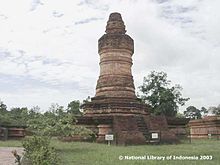Kampar Regency
Kampar Regency has a generally tropical climate, the minimum temperature occurring in November and December amounting to 21 °C.
The number of rainy days in 2009, the vast majority were around Bangkinang Seberang and Kampar Kiri.
Kampar was originally located in the province of Central Sumatra, established pursuant to Law No.
The districts (with their administrative centres) are tabulated below with their areas and their 2010[2] and 2020 Census populations,[3] together with the official estimates as at mid 2023.
In history, ethnicity, customs, and their culture is close to the Minangkabau society, particularly with the Limopuluah Luhak region.
According to his H.Takahashi in Japan and Eastern Asia, 1953, the Military Government Kaigun Kampar in Sumatra entered into Shio Riau region as part of a strategy of territorial defense military on the East coast of Sumatra.
Similarly the Batak ethnic population was found in large enough quantities to work as laborers in the plantation sector and other services.
Besides the significant number of migrants of other tribes from West Sumatra Minangkabau who made their living as traders and businessmen.
Kampar Regency has a resident Muslim majority, with minorities of Protestants, Catholics, Buddhists, and Hindus.
As one of the largest area in the province of Riau, Kampar ongoing basis to improve the facilities and infrastructure such as road network (1856.56 km), electricity (72.082 KWH) with 5 units of diesel power plant Hydroelectric Power Plant (HEPP) in Koto length that produces energy with a capacity of 114.240 KWH connected.
Fishery In the field of aquaculture catfish developed through cages (fish pond in the form of rafts) along the Kampar river, seen the number of cages were lined up neatly along the river kampardan the cooperation between the Government of Kampar PT.
Limo Koto consists of Kuok, Salo, Bangkinang, Air Tiris and Rumbio.
There are many tribal are still preserved to this day, including kinship models of maternal lines (matrilineal).
In addition, Limo Koto Kampar also has some sorts of traditional musical instruments called Calempong and Oguong.



